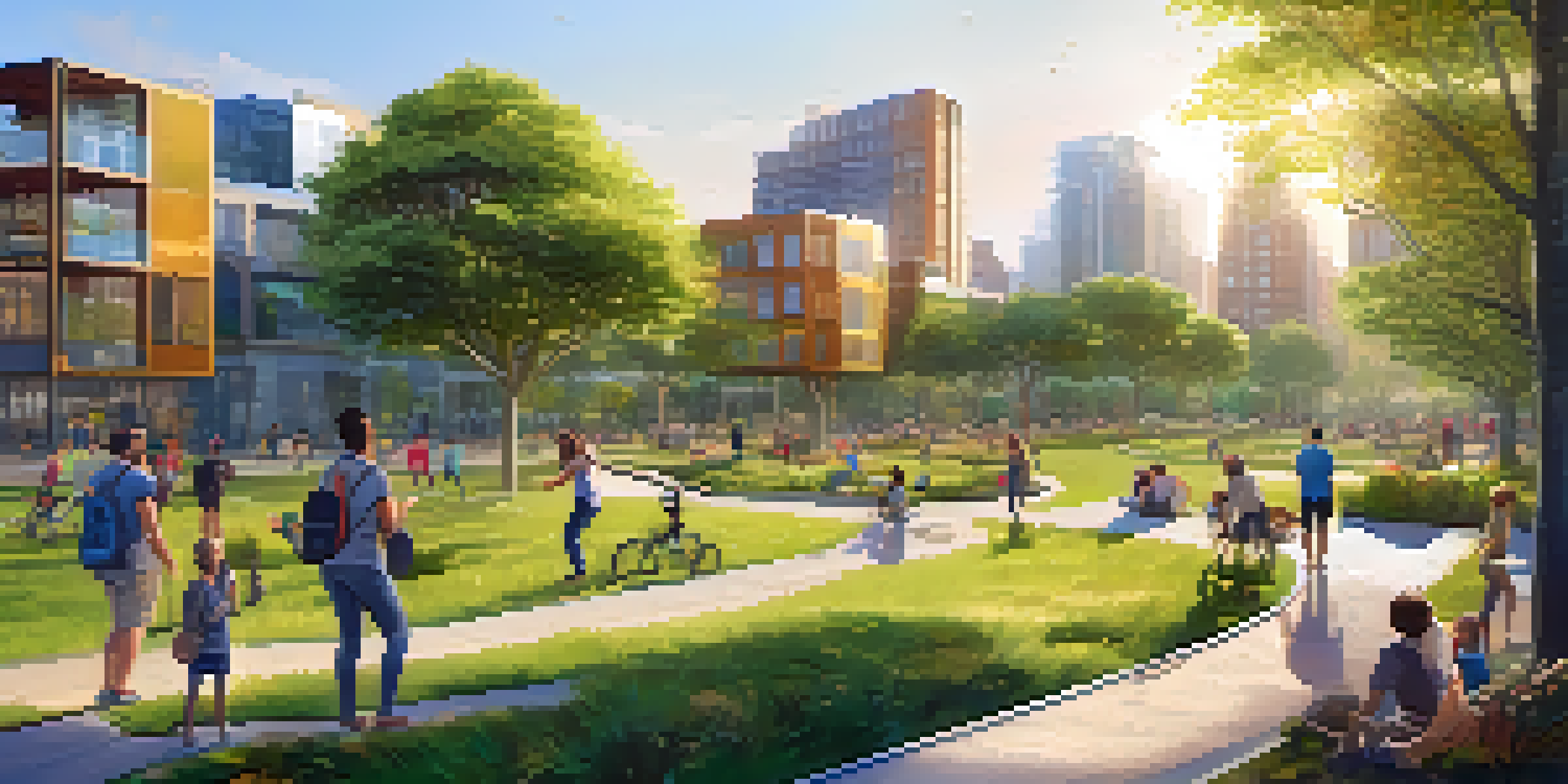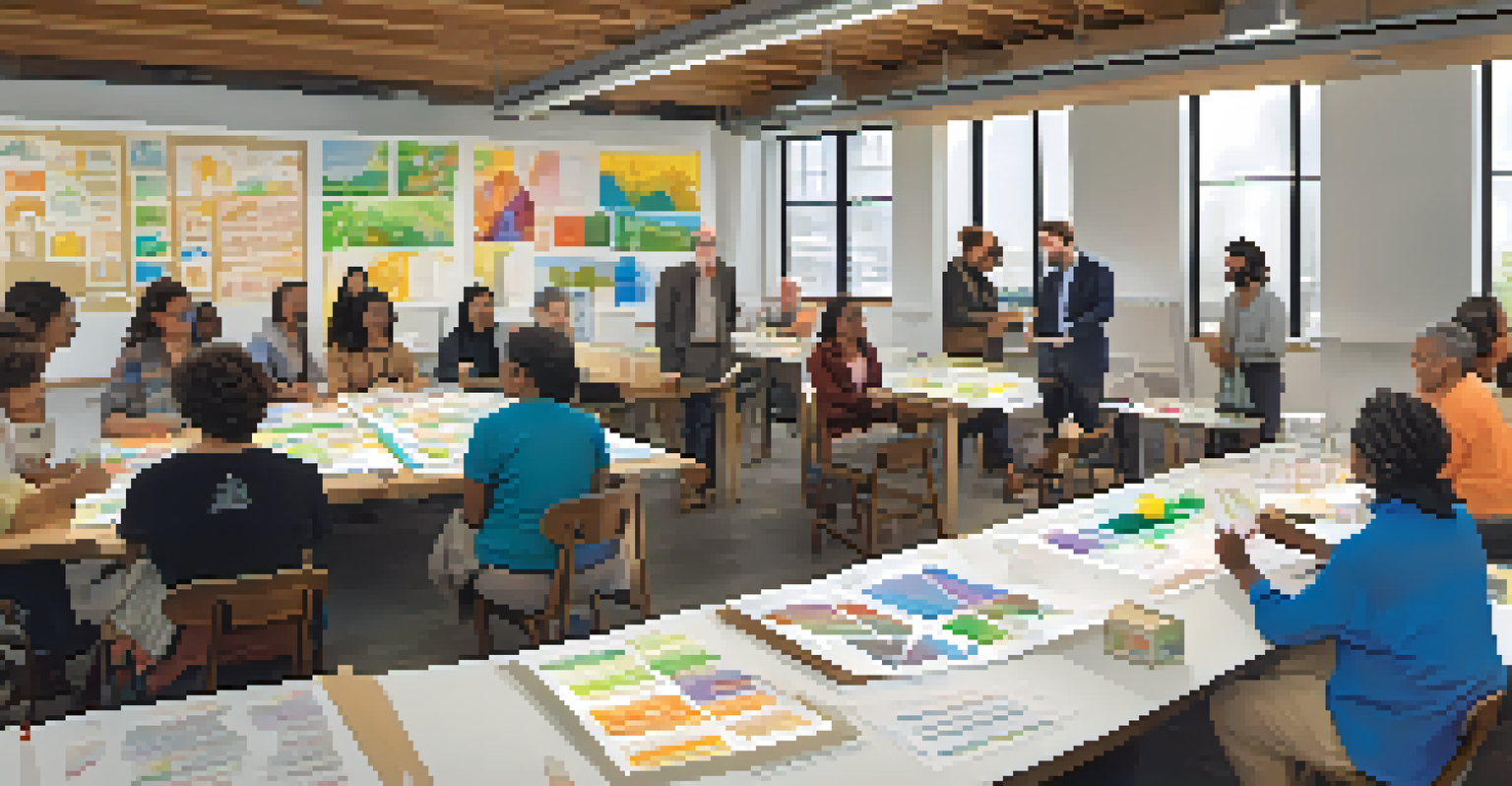Sustainable Urban Planning in Smart City Frameworks

Understanding Sustainable Urban Planning in Smart Cities
Sustainable urban planning focuses on creating cities that meet the needs of the present without compromising future generations. This concept becomes crucial as more people flock to urban areas, which can lead to overcrowding and resource depletion. Smart city frameworks leverage technology and data to enhance urban living while promoting sustainability. By integrating green spaces, efficient transport systems, and renewable energy sources, cities can become both livable and eco-friendly.
Sustainability is no longer about doing less harm. It's about doing more good.
For example, cities like Amsterdam prioritize cycling infrastructure and green public transport options. This not only reduces carbon emissions but also promotes a healthier lifestyle for residents. By considering the environmental impact of urban design, planners can create spaces that foster community engagement and social equity. Ultimately, sustainable urban planning seeks to harmonize human activity with the natural environment.
In a smart city context, data plays a pivotal role in informing sustainable practices. Sensors can track energy usage, air quality, and traffic patterns, allowing city planners to make informed decisions. This data-driven approach helps identify areas needing improvement, ensuring that resources are allocated efficiently. As technology advances, the potential for creating truly sustainable urban environments grows exponentially.
Key Principles of Sustainable Urban Planning
Several key principles guide sustainable urban planning, including mixed-use development, public transport accessibility, and green infrastructure. Mixed-use developments, which combine residential, commercial, and recreational spaces, can reduce the need for long commutes, thus lowering emissions. Public transport systems must be efficient, affordable, and widespread to encourage people to opt for transit over personal vehicles.

Green infrastructure, such as parks and green roofs, enhances urban resilience against climate change while improving residents' quality of life. It provides essential services like stormwater management and urban cooling, making cities more livable. These principles work together to create an interconnected urban landscape that fosters community interaction and environmental stewardship.
Sustainable Cities Balance Needs
Sustainable urban planning aims to meet present needs while ensuring resources for future generations.
Moreover, involving local communities in the planning process is crucial for success. By engaging residents and stakeholders, planners can better understand their needs and desires, which leads to more meaningful and accepted urban solutions. This collaborative approach ensures that sustainable urban planning reflects the unique character of each community.
The Role of Technology in Smart City Development
Technology is at the heart of smart city frameworks, enabling efficient resource management and enhanced quality of life. From smart traffic lights that optimize vehicle flow to apps that inform residents about local services, technology plays a transformative role. Through real-time data collection and analysis, cities can adapt quickly to changing circumstances, ensuring a sustainable urban environment.
The future will be about smart cities that are sustainable and livable.
For instance, cities like Singapore utilize smart sensors to monitor environmental conditions, allowing for more responsive public services. This not only improves the efficiency of city operations but also supports sustainability goals. Additionally, integrating renewable energy sources, like solar panels, with smart grids helps cities reduce reliance on fossil fuels.
However, it's essential to ensure that technology serves everyone in the community. With the rise of smart technologies, there is a risk of creating a digital divide, where some residents may not have access to these advancements. Addressing this issue is key to achieving an inclusive approach to smart city development.
Challenges in Sustainable Urban Planning
Despite its many benefits, sustainable urban planning is not without challenges. Urban sprawl, limited funding, and political will can hinder progress towards more sustainable cities. As cities expand, they often encroach on natural habitats, leading to increased pollution and loss of biodiversity. Striking a balance between development and conservation is a pressing concern for urban planners.
Moreover, securing funding for sustainable initiatives can be a significant hurdle. While many projects promise long-term savings, upfront costs can deter investment. Innovative financing mechanisms, such as public-private partnerships, can help bridge this gap and promote sustainable practices.
Technology Enhances Urban Living
Smart city frameworks use technology and data to improve resource management and quality of life.
Lastly, engaging political leaders and communities in the planning process is vital for overcoming resistance to change. By fostering a shared vision of sustainability, urban planners can unite various stakeholders and drive progress. Awareness campaigns and education can also play a crucial role in generating public support for sustainable urban planning initiatives.
Case Studies of Successful Sustainable Cities
Examining successful sustainable cities provides valuable insights into effective urban planning strategies. Take Copenhagen, for instance; this city has embraced cycling as a primary mode of transport, aiming for carbon neutrality by 2025. Their extensive bike lanes and commitment to public transport demonstrate how integrating sustainability into the urban fabric can lead to impressive results.
Another example is Vancouver, which has implemented a Greenest City Action Plan focusing on reducing greenhouse gas emissions and enhancing green spaces. By prioritizing sustainability in policies and development, Vancouver has become a model for other cities looking to elevate their sustainable urban planning efforts. These case studies highlight the importance of clear goals and community involvement.
Learning from these cities can inspire others to adopt similar strategies tailored to their unique contexts. As urban areas continue to grow, the need for effective, sustainable solutions becomes increasingly urgent. By sharing knowledge and best practices, cities can work together towards a more sustainable future.
The Importance of Community Engagement
Community engagement is a cornerstone of sustainable urban planning, ensuring that the voices of residents are heard and considered. Involving the community in decision-making processes fosters a sense of ownership and responsibility towards local environments. This involvement can take many forms, from public consultations to workshops that gather input on urban design.
When residents feel included in the planning process, they are more likely to support and advocate for sustainable initiatives. Engaging local communities also helps planners understand unique challenges and opportunities, leading to tailored solutions that resonate with the people who live there. For example, neighborhoods with active community groups often see more successful implementation of sustainability projects.
Community Engagement Drives Success
Involving local communities in planning fosters ownership and leads to more effective sustainable initiatives.
Additionally, fostering a culture of collaboration between residents, local governments, and businesses can create a shared vision for sustainable urban development. By working together, communities can address common concerns and identify innovative solutions that benefit everyone. Ultimately, community engagement is critical for creating vibrant, sustainable urban spaces.
Future Trends in Sustainable Urban Planning
The future of sustainable urban planning is bright, with several emerging trends shaping the way cities evolve. One of the most significant trends is the increasing focus on resilience in urban design. As climate change poses new challenges, cities are prioritizing adaptive strategies that can withstand environmental shocks. This includes flood-resistant infrastructure and heat mitigation measures.
Another trend is the rise of circular economies, where waste is minimized, and resources are reused. This approach encourages cities to rethink how they manage materials and energy, aiming for systems that reduce environmental impact. For instance, urban farming initiatives and repurposing vacant lots for community gardens exemplify this shift towards sustainability.

Finally, the integration of smart technology will continue to play a pivotal role in urban planning. Cities will increasingly rely on data to inform decisions, optimize resources, and enhance residents' quality of life. As these trends unfold, sustainable urban planning will evolve, paving the way for healthier, more resilient cities.